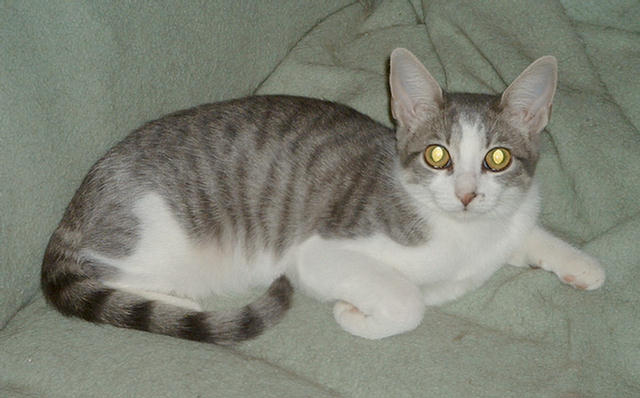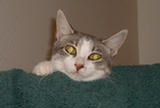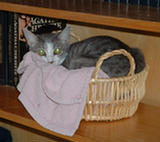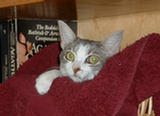|
Mirelle appeared on the windowsill of my computer room one night, when she was a tiny kitten. She was looking in at
my cats, apparently in search of company. The next night she came back at around 2:00 AM and started crying at the window.
She was only about two months old, too young to be out on her own, and I never saw any sign of a mother or littermates. I
brought her into the house and adopted her.
She was very shy, but learned to trust me to some extent. If she was on the floor when I was walking around she would run
from me, but she enjoyed being petted if she was up on something so I didn't loom over her as much. She loved being scritched
under her chin, and would purr loudly for that. While timid with humans, Mirelle got along well with other cats as long as they
weren't too rowdy. (She and Leonidas were the same age, but he was too lively for her and they were never close. She preferred
some of the more sedate adult cats.)
As Mirelle grew up, it became evident that she wasn't quite normal. Though she seemed healthy, she was more quiet and passive
than any young cat I've ever seen, seldom playing or romping, and I always had an uneasy feeling that there might be something wrong. She was also tiny --
she never got bigger than an average four-month-old kitten. When she was nine months old I noticed that she was eating less and
losing weight. I took her to the vet, and testing revealed some very bad news: Mirelle probably had FIP, and also had IMHA (immune-mediated
hemolytic anemia, an autoimmune disease that destroys the red blood cells.) There is no effective treatment or cure for FIP, and it
is fatal. IMHA can sometimes be controlled if the underlying disease causing it is treated, but with FIP that wasn't possible. All we
could do was to provide palliative care, medications that would help her feel better and might hold off the disease for a little while.
The medications did help for a time; Mirelle felt much better, though after a brief leveling off her red blood cell count continued to inexorably drop.
For just under four weeks she was cheerful and comfortable, in spite of the severe anemia. (She had probably been anemic for some time, and
her body had adapted to it to a remarkable degree.) Finally, however, she reached a point where the medications could no longer help. The FIP was
becoming more severe, her red blood cell count was extremely low, she lost her appetite and was clearly tired and uncomfortable. It
was time to let her go.
I had never lost a cat this young before, and it was very hard. No one knows why in some cats a common coronavirus mutates into FIP.
Mirelle just had bad luck, and there was nothing to be done. She was a sweet little girl, and I wish with all my heart things had worked out
otherwise, but at least her short life was peaceful and secure.

Gallery


With Other Cats

|








